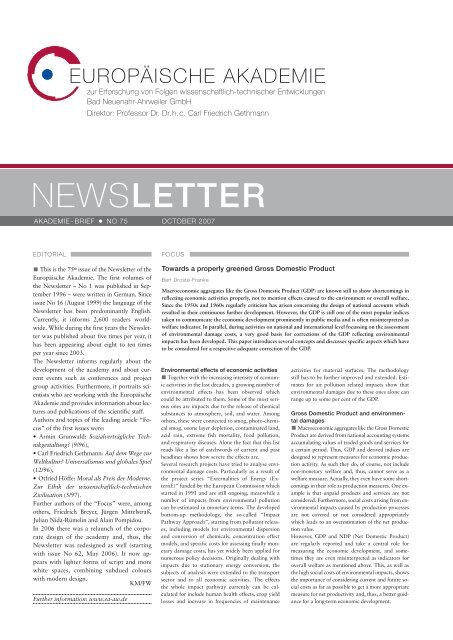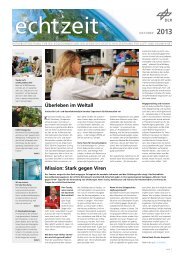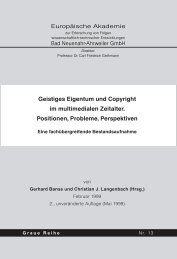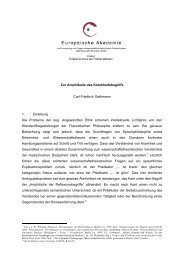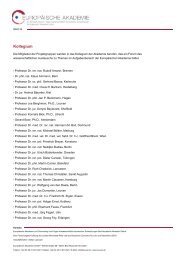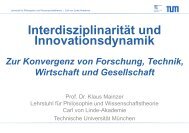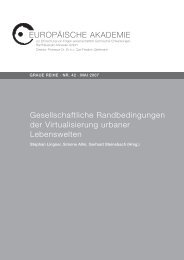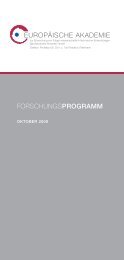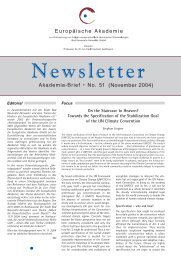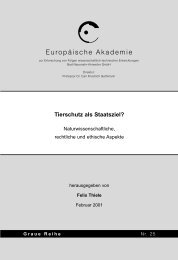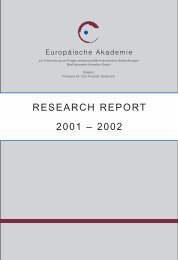Download Newsletter - Europäische Akademie Bad Neuenahr ...
Download Newsletter - Europäische Akademie Bad Neuenahr ...
Download Newsletter - Europäische Akademie Bad Neuenahr ...
You also want an ePaper? Increase the reach of your titles
YUMPU automatically turns print PDFs into web optimized ePapers that Google loves.
NEWSLETTER<br />
AKADEMIE-BRIEF ● NO 75 OCTOBER 2007<br />
EDITORIAL<br />
This is the 75 th issue of the <strong>Newsletter</strong> of the<br />
<strong>Europäische</strong> <strong>Akademie</strong>. The first volumes of<br />
the <strong>Newsletter</strong> – No 1 was published in September<br />
1996 – were written in German. Since<br />
issue No 16 (August 1999) the language of the<br />
<strong>Newsletter</strong> has been predominantly English.<br />
Currently, it informs 2,600 readers worldwide.<br />
While during the first years the <strong>Newsletter</strong><br />
was published about five times per year, it<br />
has been appearing about eight to ten times<br />
per year since 2003.<br />
The <strong>Newsletter</strong> informs regularly about the<br />
development of the academy and about current<br />
events such as conferences and project<br />
group activities. Furthermore, it portraits scientists<br />
who are working with the <strong>Europäische</strong><br />
<strong>Akademie</strong> and provides information about lectures<br />
and publications of the scientific staff.<br />
Authors and topics of the leading article “Focus”<br />
of the first issues were:<br />
• Armin Grunwald: Sozialverträgliche Technikgestaltung?<br />
(9/96),<br />
• Carl Friedrich Gethmann: Auf dem Wege zur<br />
Weltkultur? Universalismus und globales Spiel<br />
(12/96),<br />
• Otfried Höffe: Moral als Preis der Moderne.<br />
Zur Ethik der wissenschaftlich-technischen<br />
Zivilisation (5/97).<br />
Further authors of the “Focus” were, among<br />
others, Friedrich Breyer, Jürgen Mittelstraß,<br />
Julian Nida-Rümelin and Alain Pompidou.<br />
In 2006 there was a relaunch of the corporate<br />
design of the academy and, thus, the<br />
<strong>Newsletter</strong> was redesigned as well (starting<br />
with issue No 62, May 2006). It now appears<br />
with lighter forms of script and more<br />
white spaces, combining subdued colours<br />
with modern design.<br />
KM/FW<br />
Further information: www.ea-aw.de<br />
FOCUS<br />
Towards a properly greened Gross Domestic Product<br />
Bert Droste-Franke<br />
Macroeconomic aggregates like the Gross Domestic Product (GDP) are known still to show shortcomings in<br />
reflecting economic activities properly, not to mention effects caused to the environment or overall welfare.<br />
Since the 1950s and 1960s regularly criticism has arisen concerning the design of national accounts which<br />
resulted in their continuous further development. However, the GDP is still one of the most popular indices<br />
taken to communicate the economic development prominently in public media and is often misinterpreted as<br />
welfare indicator. In parallel, during activities on national and international level focussing on the assessment<br />
of environmental damage costs, a very good basis for corrections of the GDP reflecting environmental<br />
impacts has been developed. This paper introduces several concepts and discusses specific aspects which have<br />
to be considered for a respective adequate correction of the GDP.<br />
Environmental effects of economic activities<br />
Together with the increasing intensity of economic<br />
activities in the last decades, a growing number of<br />
environmental effects has been observed which<br />
could be attributed to them. Some of the most serious<br />
ones are impacts due to the release of chemical<br />
substances to atmosphere, soil, and water. Among<br />
others, these were connected to smog, photo-chemical<br />
smog, ozone layer depletion, contaminated land,<br />
acid rain, extreme fish mortality, food pollution,<br />
and respiratory diseases. Alone the fact that this list<br />
reads like a list of catchwords of current and past<br />
headlines shows how severe the effects are.<br />
Several research projects have tried to analyse environmental<br />
damage costs. Particularly as a result of<br />
the project series “Externalities of Energy (ExternE)”<br />
funded by the European Commission which<br />
started in 1991 and are still ongoing, meanwhile a<br />
number of impacts from environmental pollution<br />
can be estimated in monetary terms. The developed<br />
bottom-up methodology, the so-called “Impact<br />
Pathway Approach”, starting from pollutant releases,<br />
including models for environmental dispersion<br />
and conversion of chemicals, concentration effect<br />
models, and specific costs for assessing finally monetary<br />
damage costs, has yet widely been applied for<br />
numerous policy decisions. Originally dealing with<br />
impacts due to stationary energy conversion, the<br />
subjects of analysis were extended to the transport<br />
sector and to all economic activities. The effects<br />
the whole impact pathway currently can be calculated<br />
for include human health effects, crop yield<br />
losses and increase in frequencies of maintenance<br />
activities for material surfaces. The methodology<br />
still has to be further improved and extended. Estimates<br />
for air pollution related impacts show that<br />
environmental damages due to these ones alone can<br />
range up to some per cent of the GDP.<br />
Gross Domestic Product and environmental<br />
damages<br />
Macroeconomic aggregates like the Gross Domestic<br />
Product are derived from national accounting systems<br />
accumulating values of traded goods and services for<br />
a certain period. Thus, GDP and derived indices are<br />
designed to represent measures for economic production<br />
activity. As such they do, of course, not include<br />
non-monetary welfare and, thus, cannot serve as a<br />
welfare measure. Actually, they even have some shortcomings<br />
in their role as production measures. One example<br />
is that unpaid products and services are not<br />
considered. Furthermore, social costs arising from environmental<br />
impacts caused by production processes<br />
are not covered or not considered appropriately<br />
which leads to an overestimation of the net production<br />
value.<br />
However, GDP and NDP (Net Domestic Product)<br />
are regularly reported and take a central role for<br />
measuring the economic development, and sometimes<br />
they are even misinterpreted as indicators for<br />
overall welfare as mentioned above. This, as well as<br />
the high social costs of environmental impacts, shows<br />
the importance of considering current and future social<br />
costs as far as possible to get a more appropriate<br />
measure for net productivity and, thus, a better guidance<br />
for a long-term economic development.
2<br />
<strong>Newsletter</strong> No.75<br />
Various concepts for corrections exist<br />
Numerous concepts have been developed to improve<br />
national accounting and to derive further indices,<br />
driven by the aims either to improve the production<br />
measures or to get indicators for overall<br />
welfare or sustainable development. Accordingly,<br />
there is a great difference between the approaches.<br />
One concept is to add values to environmental aspects<br />
in physical units which then are reported as<br />
supplements in form of so-called satellite accounts.<br />
Such additional accounts do not have an influence<br />
on the macroeconomic aggregates, but could build<br />
the basis for their modification. An example for an<br />
index which seeks to indicate welfare over time,<br />
considering sustainability aspects, is the “Index of<br />
Sustainable Economic Welfare” (ISEW). It is based<br />
on the private consumption weighted by an index<br />
on income distribution and adds activities not adequately<br />
considered, corrects for long-live products,<br />
considers welfare losses, and includes further corrections<br />
concerning capital balances. One example<br />
for an index which tries to correct macroeconomic<br />
aggregates in order to measure sustainable development<br />
is the “Sustainable National Income” (SNI).<br />
It is derived by diminishing the NDP by the minimum<br />
costs for accomplishing a set of standards.<br />
Recommendations of the United Nations concerning<br />
the modification of aggregates in national accounts<br />
laid down in their concept for integrated environmental<br />
and economic accounting (SEEA)<br />
propose two ways of correction, a welfare-based<br />
correction and a correction aiming to obtain a<br />
measure indicating sustainability. As regards the<br />
first option, it is simply recommended to diminish<br />
aggregates by damage adjustments concerning the<br />
valuation of assets not yet included, by natural resource<br />
depletion, and by pollution damage to human<br />
health. In connection with the second option,<br />
it is recommended to apply economic equilibrium<br />
modelling in order to derive macroeconomic aggregates<br />
for time paths which hypothetically lead to<br />
compliance with predefined environmental standards.<br />
The German Statistische Bundesamt (Statistical<br />
Office), responsible for national accounting in<br />
Germany, currently follows the concept to provide<br />
additional environmental data in form of satellite<br />
accounts which can be used for economic modelling<br />
by research institutes. It has not yet been<br />
planned to report respective corrected aggregates.<br />
What is the task: monitoring or strategy<br />
analysis?<br />
The concepts mentioned above reveal that a decision<br />
about the tasks to be fulfilled by indicators is<br />
vital to construct appropriate indices. Intentions of<br />
indices could be to report on welfare relevant issues<br />
over time which could include sustainability aspects<br />
or to analyse strategies to achieve given targets<br />
in the future. To give a complete picture, in<br />
both cases full costs have to be taken into account<br />
which means that the damage costs as well as investments<br />
in environmental measures have to be<br />
considered. Thus, besides damages, in a damageadjusted<br />
aggregate of a welfare indicator also environment-related<br />
investment costs have to be included<br />
correctly. Furthermore, a consideration of<br />
environmental damage costs for modelling a<br />
greened economy does not only ensure that the<br />
strategy derived to meet the targets is efficient with<br />
respect to private costs but also with respect to social<br />
costs, as far as these can be assessed. Additionally,<br />
it will be possible to derive strategies efficient<br />
with respect to all costs for areas in which no targets<br />
have been set. Such a strategy could then be<br />
used to discuss disaggregated policy targets in physical<br />
units (e.g. limit values for concentration of<br />
harmful substances in air) which could facilitate the<br />
implementation of the efficient strategy. Moreover,<br />
in those areas for which social costs can be assessed<br />
and targets have already been set, it will be possible<br />
to reappraise the targets.<br />
In order to analyse details and cover also impacts<br />
which cannot be expressed adequately in monetary<br />
terms, aggregates should be supplemented by physical<br />
indicators. These are particularly important if<br />
information about environmental processes which<br />
could lead to unacceptable effects is characterised<br />
by high uncertainties or little scientific knowledge<br />
and action is urgently required. Unacceptable effects<br />
can occur if essential life-supporting functions<br />
of the environment are endangered or if the damages<br />
can only be repaired with an enormous, unacceptable<br />
effort and thus, are ‘quasi-irreversible’.<br />
Examples for such effects are potential damages to<br />
ecological systems, e.g. caused by environmental<br />
pollution or climate change. In order to monitor<br />
environmental change in these areas, indicators in<br />
physical units together with respective limit values,<br />
indicating maximum exposure which is known not<br />
to lead to unacceptable effects, are preferable, particularly<br />
because of their precision in revealing<br />
compliance with critical exposure.<br />
Application-oriented assessment of<br />
damage costs is necessary<br />
In most cases, the assessment of the damage costs<br />
due to environmental pollution can only be carried<br />
out properly if the application background is already<br />
known. Regarding the calculation it is distinguished<br />
between the originator and the place and<br />
time where and when the damages are physically<br />
caused and the effects and utility losses are observed<br />
respectively. One example may help to illustrate the<br />
issues: by emitting heavy metals to the air in Germany<br />
a polluter causes damage costs in Germany as<br />
well as in neighbouring countries. Furthermore,<br />
heavy metals are persistent and may still reach human<br />
beings via the food chain several hundred years<br />
after their release. Additionally, latency has to be<br />
taken into account and losses in utility are observed<br />
even after human health effects occur.<br />
On the one hand, from a monitoring perspective, it<br />
could be interesting which impacts or utility losses<br />
are caused or observed in the country concerned<br />
during a certain period. On the other hand, with the<br />
purpose to act against the impacts, it could also be<br />
interesting to attribute the impacts and damage<br />
costs to the originators. From the perspective of<br />
strategy analysis, it is important to know which polluter<br />
causes any damage costs and where these occur.<br />
Options for calculation are e.g.:<br />
a) Damages caused in the period, in the country;<br />
b) damages occurring in the period, in the country<br />
and<br />
c) all present and future damages caused by the<br />
country’s economic activity and related emissions,<br />
occurring inside and outside the country.<br />
Respectively, a) can be used to show effects of national<br />
measures onto the national environmental<br />
status quo, b) can be used to compare with national<br />
health statistics, and c) can be applied to find the<br />
(international and intertemporal) optimal implementation<br />
strategy of national mitigation measures<br />
concerning environmental pollution.<br />
Consistency with national accounts is<br />
required<br />
The task of providing applicable damage cost estimates<br />
becomes even more complex if the values<br />
are to be used for the correction of macroeconomic<br />
aggregates. Again, the message and the calculation<br />
instruction for the final indicator have to be clarified<br />
before the appropriate values can be estimated.<br />
Computable production losses due to losses in field<br />
<strong>Europäische</strong> <strong>Akademie</strong> <strong>Bad</strong> <strong>Neuenahr</strong>-Ahrweiler<br />
crops may have to be treated differently than increases<br />
in the maintenance costs for building facades.<br />
Accordingly, damage costs due to human<br />
health effects may need to be subdivided into productivity<br />
losses as a result of illness and premature<br />
death, costs of health treatment, and the reduction<br />
in well-being of the persons concerned, e.g. by utility<br />
losses resulting from suffer and pain. In order to<br />
implement corrections adequately, it is substantial<br />
to know additionally to which extent the components<br />
are already considered in the aggregates in focus.<br />
Moreover, if the valuation is based on surveys,<br />
the well-being component covers the consumer surplus,<br />
while other parts of the costs derived from<br />
market values do not. The consumer surplus is the<br />
additional utility a consumer gains if he or she buys<br />
a product at a lower price than he or she would have<br />
paid for it.<br />
Conclusions<br />
Methodologies for the estimation of damage<br />
costs arising from environmental impacts caused by<br />
economic activities have been developed and improved<br />
over the years. Recently, a methodology recommendation<br />
in form of a convention has been<br />
elaborated by the German Umweltbundesamt (Federal<br />
Office for the Environment). Furthermore,<br />
much experience was made and numerous recommendations<br />
exist concerning the correction of<br />
macroeconomic aggregates. Overall, this would represent<br />
a valuable starting point to elaborate respective<br />
binding concepts for official reporting in Germany.<br />
Of course, methodologies still might change<br />
and may be extended with a significant impact on<br />
the results. Therefore, a regular review and update<br />
of methodologies and results should be allowed for<br />
in such a concept and the indices should be held<br />
flexible and be open for further improvements. Such<br />
a concern will also require a practical solution by<br />
which a regular assessment of corrected aggregates<br />
is ensured so that these can be reported in parallel to<br />
the GDP and other economic indices.<br />
Dr.-Ing. Bert Droste-Franke, Dipl.-Phys., is coordinator<br />
of the project group “Fuel Cells and Virtual Power<br />
Plants as Elements for a Sustainable Development.<br />
Innovation Barriers and Implementation Strategies”<br />
at the <strong>Europäische</strong> <strong>Akademie</strong>. For his doctoral thesis<br />
he worked on the quantification of environmental<br />
damages as contribution to environmental accounting.<br />
Contact: bert.droste-franke(at)ea-aw.de<br />
WORKING GROUPS<br />
Project Group “Responsibility for Future Generations.<br />
Implementation of Sustainability in Schooling”:<br />
10.9. in <strong>Bad</strong> <strong>Neuenahr</strong>-Ahrweiler<br />
Project Group “Fuel Cells and Virtual Power<br />
Plants as Elements for a Sustainable Development<br />
Innovation Barriers and Implementation Strategies”:<br />
20.9. in <strong>Bad</strong> <strong>Neuenahr</strong>-Ahrweiler<br />
Project Group “Pharming. Genetically Modified<br />
Plants and Animals as Future Production Site of<br />
Pharmaceuticals?”: 20./21.9. and 21./22.9. in Berlin<br />
Project Group “Societal Implications of Electrical<br />
Power Grids”: 27./28.9. in Düsseldorf<br />
Project Group “The Research Guiding Function<br />
of Metaphors from the Information Sciences and<br />
their Relevance to the Transformation of the Philosophy<br />
of Man”: 27.9. in Marburg
<strong>Europäische</strong> <strong>Akademie</strong> <strong>Bad</strong> <strong>Neuenahr</strong>-Ahrweiler <strong>Newsletter</strong> No.75<br />
3<br />
Sustainability in Schooling<br />
The project group came together in <strong>Bad</strong> <strong>Neuenahr</strong>-Ahrweiler<br />
to discuss the two core-concepts of<br />
sustainability: their differences, their interrelation,<br />
and what they demand from an adequate education<br />
for sustainable development.<br />
On the one hand side there is the requirement for<br />
pure rationality to balance one’s (and the collective’s)<br />
now-for-now-preferences with one’s (and the<br />
collective’s) now-for-then-preferences. On the other<br />
hand there is the stronger concept that implies some<br />
kind of trans-generational justice. Both concepts are<br />
independent of each other which means that they<br />
sometimes complement each other, sometimes lie<br />
across with each other. Therefore, education for sustainable<br />
development does not only have to enable<br />
the learner to meet the requirement of both principles<br />
but to cope with tensions between them as well.<br />
Contact:<br />
Dr. phil. Georg Kamp, M.A.<br />
+49 (0) 2641 973-308<br />
georg.kamp(at)ea-aw.de<br />
Fuel Cells<br />
At the 7 th meeting of the project group “Fuel<br />
Cells and Virtual Power Plants as Elements for a<br />
Sustainable Development. Innovation Barriers and<br />
Implementation Strategies” further inputs in the areas<br />
of technology evaluation with respect to sustainability,<br />
innovation determinants and market imperfection,<br />
legal aspects as well as innovation barriers<br />
and strategies were discussed. Additionally, the<br />
preparation of the mid-term meeting, planned for<br />
8 th November, was continued by the project team.<br />
Contact:<br />
Dr.-Ing. Bert Droste-Franke, Dipl.-Phys.<br />
+49 (0) 2641 973-324<br />
bert.droste-franke(at)ea-aw.de<br />
Pharming<br />
The draft of the book manuscript of the project<br />
group was discussed with external experts at the<br />
mid-term meeting in Berlin (20./21.9.). First, Professor<br />
Bruce Whitelaw from the Roslin Institute in Edinburgh<br />
presented his view on the technology of<br />
pharming animals, and Dr. Stefan Schillberg from<br />
the Fraunhofer Institut in Aachen spoke about<br />
pharming plants technology. The third chapter, on<br />
environmental risks, was commented on by Priv.-<br />
Doz. Dr. Broder Breckling (Universität Bremen).<br />
The first day was concluded with criticism on aspects<br />
relating to animal welfare and ethics, provided<br />
by Professor Dr. Jörg Luy (Freie Universität Berlin).<br />
On the next day, the group first heard Professor Peter<br />
Sandøe from Københavns Universitet on ethics.<br />
Thereafter, Dr. Elmar Schmitt from Merck KGaA<br />
(Darmstadt) offered a practical perspective on drug<br />
regulatory affairs. Professor Dr. Gerd Winter (Universität<br />
Bremen) provided feedback on the chapter<br />
about legal aspects in pharming. A written commentary<br />
on legal matters specific to animal protection<br />
law was provided by Professor Dr. Müller-Terpitz<br />
(Universität Passau). Professor Gary Walsh from<br />
Limerick University who was present for the symposium<br />
that took place just after the meeting (see<br />
below) discussed the book’s introduction and technical<br />
chapters with the authors.<br />
The reviewers had gone to great length in reading<br />
the manuscript and sharing their thoughts, in many<br />
cases not just on one chapter but also on other parts<br />
of the book and on its general outlook. Very constructive<br />
interdisciplinary discussions ensued among<br />
the project group and the reviewers, and this will<br />
certainly be reflected in the final version of the<br />
book. The first conclusion from this mid-term meeting<br />
made sense to all: the working-sub-title of the<br />
project (“Genetically modified plants and animals<br />
as future production site of pharmaceuticals?”) will<br />
change, because pharming has now become a reality,<br />
with some products approved for medicinal use<br />
and more in the pipeline. Recommendations regarding<br />
the conditions for pharming and its societal, legal<br />
and ethical implications are thus highly relevant.<br />
The external experts’ comments will help to substantially<br />
improve the study which is currently being<br />
finalised and can be expected to be published next<br />
year.<br />
See also 21./22.9. the article on the symposium<br />
“New Applications of Genetic Engineering in Livestock”<br />
below.<br />
Contact:<br />
Kristin Hagen, Ph.D.<br />
+49 (0) 2641 973-318<br />
kristin.hagen(at)ea-aw.de<br />
CONFERENCES<br />
Symposium “New Applications of Genetic<br />
Engineering in Livestock”<br />
Which opportunities arise from genetically engineering<br />
farm animals, what progress is made in this<br />
technology, and which concerns should be addressed?<br />
Together with the Berlin-Brandenburgische<br />
<strong>Akademie</strong> der Wissenschaften (BBAW), the <strong>Europäische</strong><br />
<strong>Akademie</strong> had invited an interdisciplinary<br />
audience and panel of speakers to discuss these<br />
questions at the BBAW in Berlin on 21 st and 22 nd<br />
September.<br />
Professor Angelika Schnieke (Technische Universität<br />
München), who is also a member of the project<br />
group “Pharming”, told the audience about the long<br />
and difficult path to the first approval of a biopharmaceutical<br />
produced in transgenic livestock. In the<br />
late 1990ies, the expectation had been for this<br />
process to take only four to five years. However, intellectual<br />
property problems and other difficulties<br />
hampered the progress. Now, 20 years later, the<br />
breakthrough has been achieved with a human<br />
blood clotting factor produced in transgenic goats.<br />
This may just be the start: Professor Gary Walsh<br />
(University of Limerick, Ireland) spoke about the<br />
growing market for biopharmaceuticals, and how<br />
transgenic animals may play a role in delivering to it.<br />
Will transgenic animals also have a breakthrough in<br />
food production? Professor Heiner Niemann (FAL<br />
Mariensee) thought so and expressed his view that in<br />
20 years, genetic engineering will probably be one<br />
method among others for breeding desired traits in<br />
farm animals. He introduced the audience to the many<br />
potentials of transgenic farm animals: besides medical<br />
applications as bioreactors, medical models and organ<br />
donors, transgenic farm animals are also envisaged to<br />
provide healthier food products, healthier production<br />
animals, and a better environment. Some genetically<br />
engineered lines are already waiting for market approval:<br />
transgenic salmon that grow quickly, cows<br />
that are resistant to udder inflammation, and pigs that<br />
have reduced phosphate content in their faeces.<br />
Professor Louis-Marie Houdebine (INRA, Jouy-en-<br />
Josas, France) explained to the audience the biotechnological<br />
challenges and possible solutions at the forefront<br />
of research. Refinement of these methods is<br />
important not only for effective production of transgenic<br />
“founder animals” (this is how the first transgenic<br />
generation is called) but also for elimination of<br />
side-effects on animal welfare. However, as the audience<br />
learned from Professor Adroaldo Zanella<br />
(Norges Veterinærhøgskole, Norway), little is at present<br />
known about the potential effects of genetic engineering<br />
on animal welfare. He explained that how animals<br />
can cope with challenges depends partly on the<br />
expression of specific proteins in their brains, and genetic<br />
changes could influence these mechanisms. Dr.<br />
Kees van Reenen (ID Lelystad, The Netherlands) explained<br />
a biotechnology-integrated approach to investigating<br />
effects of transgenesis on animal welfare by<br />
testing the appropriate generations of a transgenic line<br />
bred from the founder animals.<br />
Professor Matthias Kaiser (The National Committee<br />
for Research Ethics in Science and Technology in Norway)<br />
suggested that in order to justify taking risks<br />
with a technology, it is not sufficient to identify a benefit.<br />
He called for an integrated ethical assessment<br />
where risks and benefits are seen in their societal perspective<br />
(e.g. who benefits?, who takes on responsibility?).<br />
Kaiser argued for a transparent democratic ethical<br />
debate where scientists take the initiative to also<br />
explain the scientific insecurities regarding the consequences<br />
of the technology. He stressed that given the<br />
plurality of values and complex risks, the precautionary<br />
principle needs to be observed and each product<br />
should be evaluated case-by-case. In the near future,<br />
he thought that only “pharming” would hold the<br />
promise of sufficient benefits to counter objections to<br />
the use of transgenic farm animals.<br />
Contributions to the symposium will be published in<br />
2008.<br />
Contact:<br />
Kristin Hagen, Ph.D.<br />
+49 (0) 2641 973-318<br />
kristin.hagen(at)ea-aw.de<br />
ESF/ESA/ESPI Conference “Humans in<br />
Outer Space – Interdisciplinary Odysseys”<br />
Space-faring nations are heading again for human exploration<br />
of the Moon and, eventually, of Mars. Corresponding<br />
plans and perspectives gave reason for the<br />
a.m. conference which took place in Vienna from 11 th<br />
to 12 th October. The conference was jointly organised<br />
by the European Science Foundation, the European<br />
Space Agency, and the European Space Policy Institute;<br />
it aimed at a comprehensive trans-disciplinary<br />
dialogue on manned space exploration beyond technological<br />
questions. Dr. Stephan Lingner was invited<br />
to present views from the humanities on the cultural<br />
dimension of human space exploration.<br />
Contact:<br />
Dr. rer. nat. Stephan Lingner, Dipl.-Geol.<br />
+49 (0) 2641 973-306<br />
stephan.lingner(at)ea-aw.de<br />
NEWS<br />
Art Exhibition<br />
The next opening of an <strong>Europäische</strong> <strong>Akademie</strong> art<br />
exhibiton will take place on 15 th November at the<br />
<strong>Europäische</strong> <strong>Akademie</strong>, Wilhelmstr. 56, in 53474<br />
<strong>Bad</strong> <strong>Neuenahr</strong>-Ahrweiler. The artist, Beate Leisten,<br />
will present her latest works. Leisten is a regional<br />
artist and this is her second exhibition at the<br />
academy. The exhibition, which is supported by the<br />
sponsors’ club (Verein der Förderer), can then be<br />
visited during the opening hours of the academy.<br />
Further information: www.ea-aw.de
4<br />
PUBLICATIONS<br />
Carl Friedrich Gethmann<br />
“Ethische Aspekte zukünftiger globaler Stromerzeugung”,<br />
Kraftwerke 2007 (19.–21. September 2007),<br />
Salzburg 2007, p.1–3<br />
Kristin Hagen<br />
“Animal welfare aspects of creating transgenic farm<br />
animals”, in: W. Zollitsch, C. Winkler, S. Waiblinger,<br />
A. Haslberber (eds.), Sustainable food production<br />
and ethics, Wageningen 2007<br />
Karsten Mause<br />
Konsumentenschutz im Hochschulbereich. Unvollständige<br />
Nachfragerinformation, Marktversagen &<br />
markt-basierte Schutzmechanismen, Berlin, 2007<br />
LECTURES<br />
<strong>Newsletter</strong> No.75<br />
Carl Friedrich Gethmann<br />
20.9.07<br />
“Ethische Aspekte zukünftiger globaler Stromerzeugung”,<br />
VGB-Kongress Kraftwerke 2007 (plenary<br />
lecture)<br />
29.9.07<br />
“Wittgensteins angeblicher Sprachspielrelativismus<br />
und das Problem trans-kontextueller Geltungsansprüche:<br />
Wittgenstein: Philosophie und Wissenschaften”,<br />
Forum für Philosophie der Deutschen<br />
Gesellschaft für Philosophie, Leipzig<br />
Kristin Hagen<br />
15.9.07<br />
“Animal welfare aspects of creating transgenic farm<br />
animals”, 7 th Congress of the European Society for<br />
Agricultural and Food Ethics, Wien<br />
Stephan Lingner<br />
12.10.07<br />
“Human spaceflight as a matter of culture and national<br />
vision”, ESF/ESA/ESPI Conference Humans<br />
in Outer Space – Interdisciplinary Odysseys, Vienna<br />
Karsten Mause<br />
13.9.07<br />
“To License or to Certify Higher Education Institutions?<br />
That is (Still) the Question”, 24 th Annual<br />
Conference of the European Association of Law and<br />
Economics at Copenhagen Business School, Denmark<br />
15.9.07<br />
Comment on Stefano Clo “Assessing the European<br />
Emissions Trading Scheme’s Effectiveness: Have<br />
CO 2 Tradable Permits Been Over-Allocated?”, 24 th<br />
Annual Conference of the European Association of<br />
Law and Economics at Copenhagen Business<br />
School, Denmark<br />
Katja Stoppenbrink<br />
24.7.07<br />
“Gehört mein Körper mir? – Rechtsdogmatische<br />
und -philosophische Überlegungen zu Geltungsgründen<br />
und Grenzen des rechtlichen Kommerzialisierungsverbots<br />
menschlicher Körper(teile)”, Summer<br />
School “Der menschliche Körper zwischen<br />
Vermarktung und Unverfügbarkeit. Ethische,<br />
rechtliche und soziale Aspekte der Kommerzialisierung<br />
des menschlichen Körpers und seiner Teile”,<br />
20.–27.7.07, Interfakultäres Zentrum für Ethik in<br />
den Wissenschaften (IZEW), Eberhard-Karls-Universität<br />
Tübingen<br />
30.7.07<br />
“Enhancement without any effort? – Justifying<br />
shortcuts to self-creation”, 2 nd Annual Postgraduate<br />
Conference in Bioethics: “Why Bioethics? Our research<br />
in context”, 30./31.7.07, King’s College in<br />
Cambridge, UK<br />
18.9.07<br />
“Brain Computer Interfaces (BCI) – Gedankenexperimente<br />
oder Gefährdung der ‘Natur des Menschen’?”,<br />
Summer School “Die Technisierung des<br />
Gehirns. Ethische Aspekte aktueller Neurotechnologien”,<br />
16.–23.9.07, research group of the Federal<br />
Ministry of Science and Education “Zur Relevanz<br />
der »Natur des Menschen« als Orientierungsnorm<br />
für Anwendungsfragen der biomedizinischen<br />
Ethik”, Institut für Ethik und Geschichte der Medizin,<br />
Albert-Ludwigs-Universität Freiburg<br />
Publisher:<br />
<strong>Europäische</strong> <strong>Akademie</strong> zur Erforschung von Folgen wissenschaftlich-technischer Entwicklungen<br />
<strong>Bad</strong> <strong>Neuenahr</strong>-Ahrweiler GmbH, Wilhelmstraße 56, D-53474 <strong>Bad</strong> <strong>Neuenahr</strong>-Ahrweiler<br />
E-Mail:<br />
europaeische.akademie@ea-aw.de, Internet: www.ea-aw.de<br />
Director:<br />
Professor Dr. phil. Dr. phil. h.c. Carl Friedrich Gethmann (V.i.S.d.P.)<br />
Editing:<br />
Katharina Mader, M.A., Phone +49 (0) 26 41 973-313, Fax 973-320, katharina.mader@ea-aw.de<br />
Print:<br />
Warlich Druck Ahrweiler GmbH, <strong>Bad</strong> <strong>Neuenahr</strong>-Ahrweiler<br />
ISSN 1432-0150, frequency of publication: 6 –10 times per year, 2.700 copies,<br />
reproduction is permitted with reference to the source, please send two voucher copies.<br />
<strong>Europäische</strong> <strong>Akademie</strong> <strong>Bad</strong> <strong>Neuenahr</strong>-Ahrweiler<br />
PERSONALITIES<br />
THOMAS ZIESEMER, born in Kiel in 1953, is<br />
associate professor of economics at the University<br />
of Maastricht. He studied Economics<br />
at the universities of Kiel and Regensburg<br />
where he graduated in 1978, worked from<br />
1982 to 1989, and obtained his Ph.D. in<br />
1985. At the University of Maastricht he was<br />
assistant professor of international economics<br />
from 1989 to 1994 and associate professor<br />
of microeconomics from 1994 to 1996.<br />
He obtained his habilitation at the Freie Universität<br />
Berlin in 1996.<br />
He worked as head of the Macroeconomics<br />
Division at the Research Insitute MERIT from<br />
2001 to 2006 and coordinated the research<br />
programme “The Role of Technology in<br />
Growth and Development” at UNU-MERIT<br />
from 2006 to 2007.<br />
He is fellow of the Research School METE-<br />
OR and member of the board of the Netherlands<br />
Network in Economics. His fields of<br />
interest are: Development, International and<br />
Environmental Economics, Growth, and<br />
Technical Change. Information on his publications<br />
are available from the data bank<br />
‘ideas’ and on his website at UNU-MERIT:<br />
http://www.eaepe.infonomics.nl<br />
At the <strong>Europäische</strong> <strong>Akademie</strong> GmbH Professor<br />
Dr. rer. pol. Thomas Ziesemer participated in the<br />
project “Sustainable Development and Innovation in<br />
the Energy Sector” from 2000 to 2002. Currently he<br />
is member of the project group “Fuel Cells and Virtual<br />
Power Plants as Elements for a Sustainable<br />
Development. Innovation Barriers and Implementation<br />
Strategies”.<br />
On 22 nd November, 7.30 pm, Professor Dr. Thomas<br />
Ziesemer will dispute with Professor Dr. Klaus Heinloth<br />
(Physikalisches Institut, Universität Bonn) on<br />
the topic “Renaissance of nuclear power?” at this<br />
year’s Ahrtal Talk. The sponsors’ club of the<br />
<strong>Europäische</strong> <strong>Akademie</strong> invites to the event at the<br />
Klosterruine Marienthal, Klosterstraße 3–5, 53507<br />
Marienthal. Further information: www.ea-aw.de


